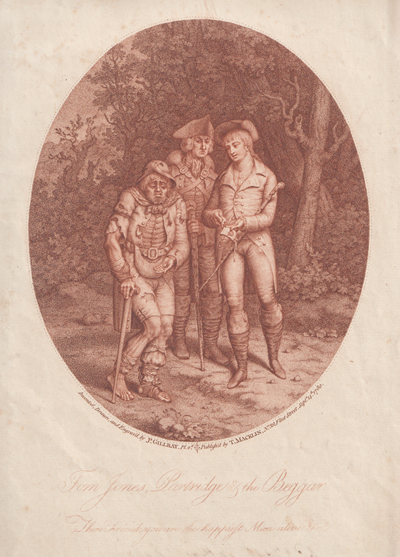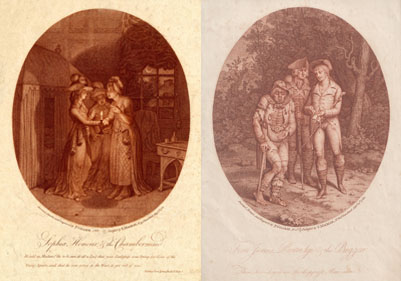Tom Jones, Partridge, & the Beggar
This is the extremely rare second plate of a paired set of carefully crafted stipple engravings in the manner of Francesco Bartolozzi illustrating two scenes from Henry Fielding's classic novel Tom Jones.* The other plate is Sophia, Honour, & the Chambermaid. Taken together, they represent the first of a number of attempts Gillray made throughout the 1780s to be regarded as a "serious" artist rather than as a caricaturist. If you have arrived at this print without looking at the first print of the set, please start with that one which contains the larger context and background for the pair.

[September 14, 1780]
© Donald Coverdale, Private Collection
Plate 2 is based on a scene from Book XII Chapter 4 of the novel after the misunderstandings featured in Plate 1 at the Inn at Upton. Inadvertently treading the same path that Sophia and Honour followed the previous evening, Tom and Partridge come upon a poor, lame, and illiterate beggar. Against the stern advice of Partridge who asserts that "Every parish should keep their own poor," the generous-hearted Tom gives the man a shilling from his own meagre supply. Upon receiving the shilling, the beggar then offers to "sell" Tom a gilt pocket-book that he has found along the road. Upon examination, Tom discovers the name of Sophia Western as well as a bank note for a substantial sum which Sophia had received from her father before running away to avoid marrying Master Blifil. Overjoyed to have something of Sophia's but worried that she should now be without it, Tom "purchases" the pocket-book for a guinea and informs the beggar that he knows the owner and intends to make sure that it gets back to her. Initially overjoyed at receiving the guinea, the beggar now puts on "a discontented look, and, scratching his head, said, 'He hoped his worship would give him something more.'
'Lookee, friend,' cries Jones, the right owner shall certainly have again all that she lost; and as for any further gratuity, I really cannot give it you at present; but let me know your name and where you live, and it is more than possible, you may hereafter have further reason to rejoice at this morning's adventure.'
Overcoming the beggar's further reluctance, Jones writes the beggar's name and address on a piece of paper and inserts it in the notebook where Sophia had written her name, exclaiming "There, friend, you are the happiest man alive. I have joined your name to that of an angel."
Thanks to Donald Coverdale, we have a scratched proof of the plate indicating the actual title and a version (?) of the caption: "There, friend, you are the happiest man alive &". But the proof is still lacking the source of the scene, (i.e. Book XII Chap. 4) To be consistent with Plate 1, one would expect that in the final version Gillray would have added that source and, perhaps, a second line of the caption including the second sentence of Jones's exclamation. That would have brought the title closer to the oval frame as in Plate 1.

Seen as a demonstation of Gillray's abilities, the two plates are clearly meant to be complementary. The first is set indoors and at night; the second is set outside during the day. So we can admire his handling of both interiors and exteriors, partial and full light. From a structural and design point of view, they are mirror images. In the first plate, we see (from left to right) Sophia, Honour, and the Chambermaid. Sophia is facing right and the disapproving Honour is in the center. In plate two we have (from right to left) Tom, Partrige, and the Beggar. Tom is looking left and the equally disapproving Partridge occupies the center. Thematically, both Sophia and Tom demonstrate a touching naiveté and generosity towards the less fortunate (the chamber maid and the beggar) that is wholly lacking in their companions. And if the first plate may have left the impression that Jones is a cad, the second plate corrects that view and prepares for the conclusion of the novel where Tom and Sophia's names are joined and Jones becomes the "the happiest man alive."
* Thanks to Donald Coverdale for allowing me to reproduce his copy of the print here. The only other copy I've been able to find (at the National Portrait Gallery) is cropped to the oval frame around the image, cutting off the title and caption. The rarity of a copy with the full title may explain why Draper Hill mistakenly refers to the print as Jones, Partridge, and the Cripple. (p.22) He may not have seen a copy with the actual title.
Sources and Reading
- Draper Hill, Mr. Gillray The Caricaturist, 1965, pp. 15, 21-22.
- Book Illustration in Eighteenth-Century England
- The Royal Academy of Arts and its Anatomical Teachings
- "Thomas Macklin," Wikipedia
Comments & Corrections
NOTE: Comments and/or corrections are always appreciated. To make that easier, I have included a form below that you can use. I promise never to share any of the info provided without your express permission.